Check Out Acclaimed Tasks by Renowned CDA Architects
Check Out Acclaimed Tasks by Renowned CDA Architects
Blog Article
Recognizing the Collaborative Refine In Between Designers and Engineers in Modern Building And Construction Projects
The collective process in between engineers and engineers is important in modern building tasks, as it harmonizes style intent with design usefulness. This collaboration not only influences the visual and useful facets of a job however also plays an important function in addressing sustainability obstacles. By utilizing effective interaction approaches and leveraging sophisticated technologies, such as Building Details Modeling (BIM), groups can work more cohesively. The details of this cooperation commonly existing distinct difficulties that can hinder progress. Exploring these characteristics reveals understandings that can significantly influence project results and total sector requirements. cda architects.
The Importance of Cooperation
The collaborative synergy in between architects and designers is necessary for the successful understanding of any building project. This collaboration brings together distinctive knowledge and perspectives, making it possible for the integration of innovative layout with useful design remedies. By working with each other, designers and designers can guarantee that a task not only fulfills aesthetic and functional needs but likewise sticks to safety, sustainability, and budgetary restrictions.
Collaboration fosters a shared vision, facilitating the positioning of objectives and assumptions from the start. This positioning is critical in resolving potential difficulties and mitigating dangers that can emerge during the project lifecycle. A collaborative method permits for the efficient allowance of resources, optimizing both time and cost.
The relevance of partnership includes the iterative procedure of layout and construction, where responses from engineers can inform building decisions, causing even more feasible and lasting styles. Alternatively, architects can motivate engineers to believe creatively about just how to attain architectural stability without jeopardizing imaginative intent. Ultimately, the collaborative connection in between architects and designers is not simply beneficial; it is essential to the development of premium, practical, and cutting-edge built settings that meet the requirements of society.
Communication Strategies and Tools
Efficient communication methods and tools are essential for promoting collaboration in between architects and designers throughout the task lifecycle. Developing clear networks of interaction is necessary to make certain that all team members are aligned with job goals, timelines, and duties. Normal conferences, both in-person and virtual, provide possibilities for stakeholders to review progression, address concerns, and make informed decisions.

Furthermore, adopting joint communication devices, such as Slack or Microsoft Teams, permits immediate messaging, data sharing, and recurring conversations, promoting a much more agile action to emerging issues. Record administration systems also play an essential duty in organizing job paperwork, making certain that all employee have accessibility to the most up to date info.
Shared Goals and Task Vision
A merged task vision works as the foundation for successful cooperation in between designers and engineers (cda architects). This common vision not only straightens the efforts of both celebrations yet likewise develops a typical structure for decision-making throughout the task's lifecycle. By verbalizing clear goals, stakeholders can properly navigate the complexities of contemporary construction projects, ensuring that both aesthetic and practical needs are satisfied
Developing shared goals includes open dialogue and a detailed understanding of each discipline's contributions. Designers normally concentrate on design intent, spatial connections, and user experience, while engineers highlight structural stability, systems performance, and compliance with guidelines. When these viewpoints are straightened, the outcome is a natural task that follows both imaginative goals and technical usefulness.
Moreover, a distinct task vision fosters liability among employee, encouraging each try this site individual to take possession of their duty in accomplishing the wanted outcome. Regular check-ins and collaborative workshops can even more enhance this commitment, enabling adjustments to be made as the job develops. Inevitably, a shared vision not only boosts teamwork however additionally elevates the top quality of the last deliverable, leading to effective job conclusion.
The Function of Innovation
Leveraging modern technology has ended up being vital in boosting partnership between designers and designers. Structure Information Modeling (BIM) stands out as a pivotal modern technology, permitting both architects and engineers to develop comprehensive 3D versions that envelop design intent and architectural integrity.
Moreover, cloud-based platforms allow seamless collaboration, allowing task stakeholders to access and update job information from anywhere. This cultivates a culture of transparency and responsibility, as adjustments can be tracked and evaluated in real-time. In addition, mobile applications more enhance interaction, offering on-site teams with instant accessibility to job requirements and updates.
Emerging technologies such as synthetic intelligence and artificial intelligence are also starting to play a browse around this web-site duty in predictive evaluation, assisting groups recognize possible problems prior to they arise. Eventually, the role of modern technology in architecture-engineering cooperation not just improves workflow efficiencies but likewise enhances technology, resulting in more successful task results. By accepting these technological improvements, architects and designers can make sure a more natural and efficient joint process throughout the building lifecycle.
Study in Successful Collaborations
Many situation researches show the profound impact of effective partnerships between designers and engineers on job outcomes. One remarkable example is the collaboration on the High Line in New York City City, where landscape engineers, designers, and metropolitan organizers interacted to transform a deserted rail line right into a dynamic public park. This multidisciplinary technique not only improved the visual quality however likewise ensured structural security and ecological sustainability.

The Burj Khalifa in Dubai better demonstrates the importance of joint initiatives - cda architects. The assimilation of style and engineering competence allowed the project group to attain unprecedented elevations while sticking to safety and security guidelines and aesthetic vision
These examples emphasize the relevance of interaction, depend on, and shared goals. In today's complicated construction setting, such collaborations are necessary to browsing difficulties and supplying tasks that fulfill both functional and visionary goals.
Conclusion
In conclusion, the partnership between designers and engineers is necessary for the success of modern-day building and construction tasks. Reliable interaction methods, a common job vision, and the combination of sophisticated company website innovations are important elements that facilitate this partnership. By fostering a culture of accountability and leveraging devices such as Structure Info Modeling (BIM), teams can navigate project complexities, ensuring that visual, functional, and sustainability purposes are attained. Eventually, this synergy results in innovative and successful project end results.
Report this page